Founded in 1938 and published semiannually by Sophia University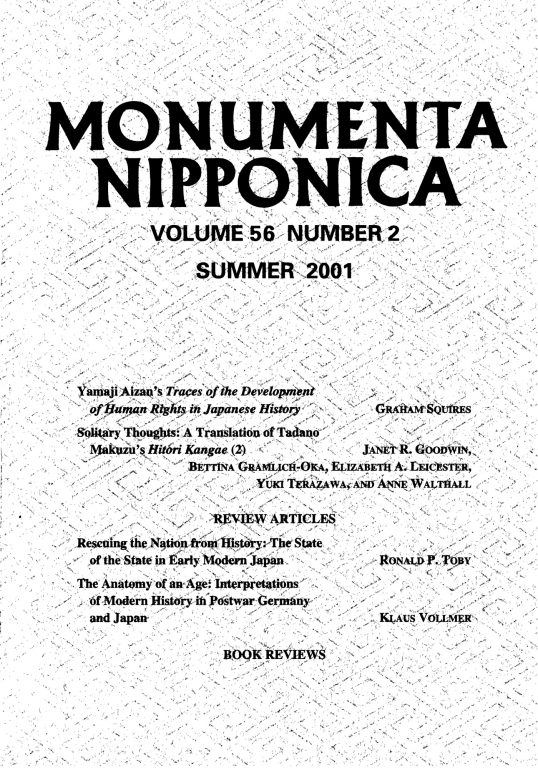 MN 56:2 (2001) 197–237Rescuing the Nation from History: The State of the State in Early Modern JapanRonald P. Toby
MN 56:2 (2001) 197–237Rescuing the Nation from History: The State of the State in Early Modern JapanRonald P. Toby MN 56:2 (2001) 239–54The Anatomy of an Age: Interpretations of Modern History in Postwar Germany and JapanKlaus Vollmer
MN 56:2 (2001) 239–54The Anatomy of an Age: Interpretations of Modern History in Postwar Germany and JapanKlaus Vollmer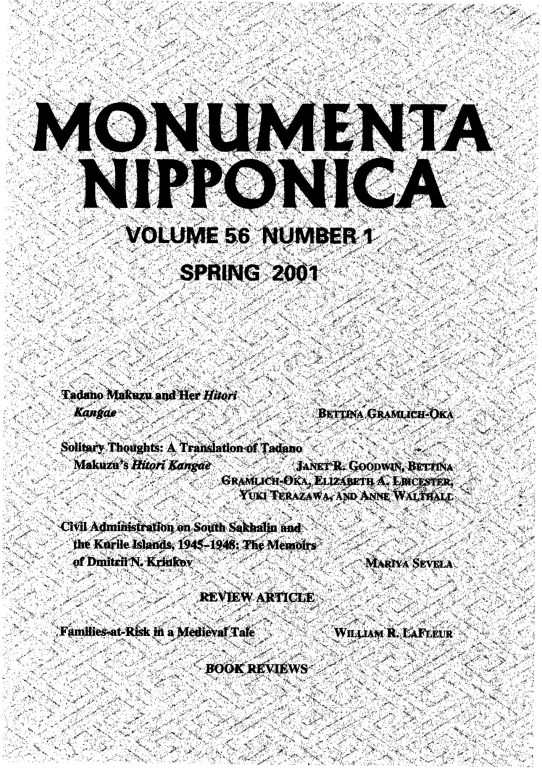 MN 56:1 (2001) 1–38Tadano Makuzu and Her Hitori KangaeBettina Gramlich-Oka
MN 56:1 (2001) 1–38Tadano Makuzu and Her Hitori KangaeBettina Gramlich-Oka MN 56:1 (2001) 39–91Civil Administration on South Sakhalin and the Kurile Islands, 1945–1948: The Memoirs of Dmitrii N. KriukovMariya Sevela
MN 56:1 (2001) 39–91Civil Administration on South Sakhalin and the Kurile Islands, 1945–1948: The Memoirs of Dmitrii N. KriukovMariya Sevela MN 56:1 (2001) 93–98Families-at-Risk in a Medieval TaleWilliam R. LaFleur
MN 56:1 (2001) 93–98Families-at-Risk in a Medieval TaleWilliam R. LaFleur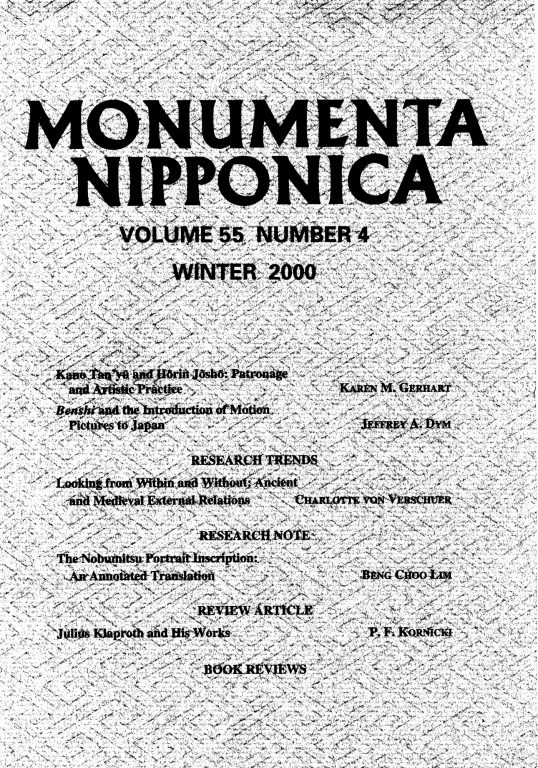 MN 55:4 (2000) 483–508Kano Tan’yū and Hōrin Jōshō: Patronage and Artistic PracticeKaren M. Gerhart
MN 55:4 (2000) 483–508Kano Tan’yū and Hōrin Jōshō: Patronage and Artistic PracticeKaren M. Gerhart MN 55:4 (2000) 509–536Benshi and the Introduction of Motion Pictures to JapanJeffrey A. Dym
MN 55:4 (2000) 509–536Benshi and the Introduction of Motion Pictures to JapanJeffrey A. Dym MN 55:4 (2000) 537–566Looking from Within and Without: Ancient and Medieval External RelationsCharlotte von Verschuer
MN 55:4 (2000) 537–566Looking from Within and Without: Ancient and Medieval External RelationsCharlotte von Verschuer MN 55:4 (2000) 567–577The Nobumitsu Portrait Inscription: An Annotated TranslationBeng Choo Lim
MN 55:4 (2000) 567–577The Nobumitsu Portrait Inscription: An Annotated TranslationBeng Choo Lim MN 55:4 (2000) 579–591Julius Klaproth and His WorksPeter F. Kornicki
MN 55:4 (2000) 579–591Julius Klaproth and His WorksPeter F. Kornicki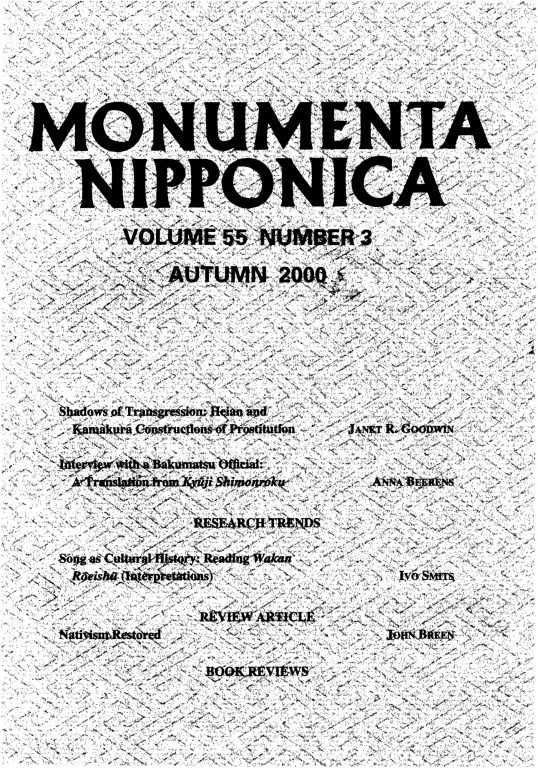 MN 55:3 (2000) 327–68Shadows of Transgression: Heian and Kamakura Constructions of ProstitutionJanet R. Goodwin
MN 55:3 (2000) 327–68Shadows of Transgression: Heian and Kamakura Constructions of ProstitutionJanet R. Goodwin MN 55:3 (2000) 369–98Interview with a Bakumatsu Official: A Translation from Kyūji Shimonroku (Part 1)Anna Beerens
MN 55:3 (2000) 369–98Interview with a Bakumatsu Official: A Translation from Kyūji Shimonroku (Part 1)Anna Beerens MN 55:3 (2000) 399–427Song as Cultural History: Reading Wakan Rōeishū (Part 2: Interpretations)Ivo Smits
MN 55:3 (2000) 399–427Song as Cultural History: Reading Wakan Rōeishū (Part 2: Interpretations)Ivo Smits MN 55:3 (2000) 429–39Nativism RestoredJohn Breen
MN 55:3 (2000) 429–39Nativism RestoredJohn Breen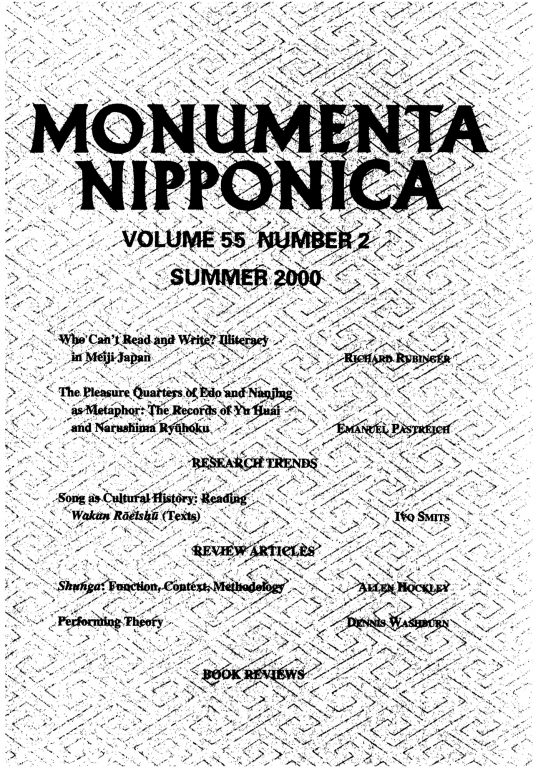 MN 55:2 (2000) 163–98Who Can’t Read and Write? Illiteracy in Meiji JapanRichard Rubinger
MN 55:2 (2000) 163–98Who Can’t Read and Write? Illiteracy in Meiji JapanRichard Rubinger MN 55:2 (2000) 199–224The Pleasure Quarters of Edo and Nanjing as Metaphor: The Records of Yu Huai and Narushima RyūhokuEmanuel Pastreich
MN 55:2 (2000) 199–224The Pleasure Quarters of Edo and Nanjing as Metaphor: The Records of Yu Huai and Narushima RyūhokuEmanuel Pastreich MN 55:2 (2000) 225–56Song as Cultural History: Reading Wakan Rōeishū (Part 1: Texts)Ivo Smits
MN 55:2 (2000) 225–56Song as Cultural History: Reading Wakan Rōeishū (Part 1: Texts)Ivo Smits MN 55:2 (2000) 257–69Shunga: Function, Context, MethodologyAllen Hockley
MN 55:2 (2000) 257–69Shunga: Function, Context, MethodologyAllen Hockley MN 55:2 (2000) 271–81Performing TheoryDennis Washburn
MN 55:2 (2000) 271–81Performing TheoryDennis Washburn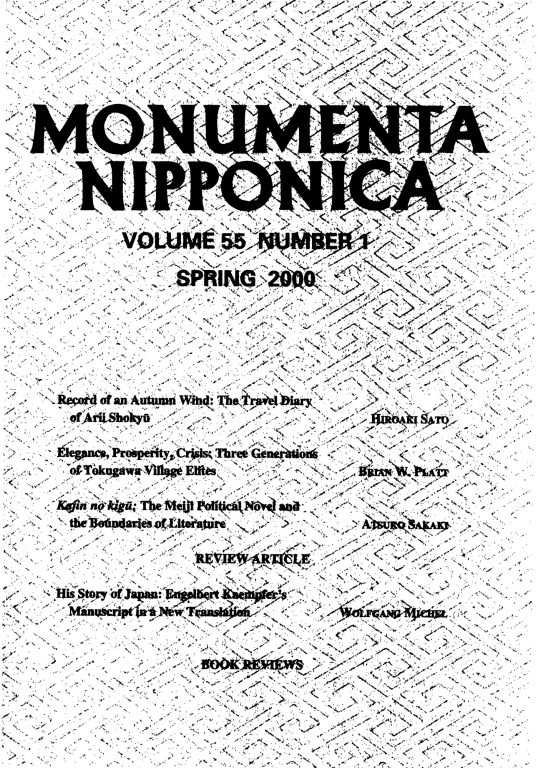 MN 55:1 (2000) 1–43Record of an Autumn Wind: The Travel Diary of Arii ShokyūHiroaki Sato
MN 55:1 (2000) 1–43Record of an Autumn Wind: The Travel Diary of Arii ShokyūHiroaki Sato MN 55:1 (2000) 45–81Elegance, Prosperity, Crisis: Three Generations of Tokugawa Village ElitesBrian W. Platt
MN 55:1 (2000) 45–81Elegance, Prosperity, Crisis: Three Generations of Tokugawa Village ElitesBrian W. Platt MN 55:1 (2000) 83–108Kajin no Kigū: The Meiji Political Novel and the Boundaries of LiteratureAtsuko Sakaki
MN 55:1 (2000) 83–108Kajin no Kigū: The Meiji Political Novel and the Boundaries of LiteratureAtsuko Sakaki MN 55:1 (2000) 109–20His Story of Japan: Engelbert Kaempfer’s Manuscript in a New TranslationWolfgang Michel
MN 55:1 (2000) 109–20His Story of Japan: Engelbert Kaempfer’s Manuscript in a New TranslationWolfgang Michel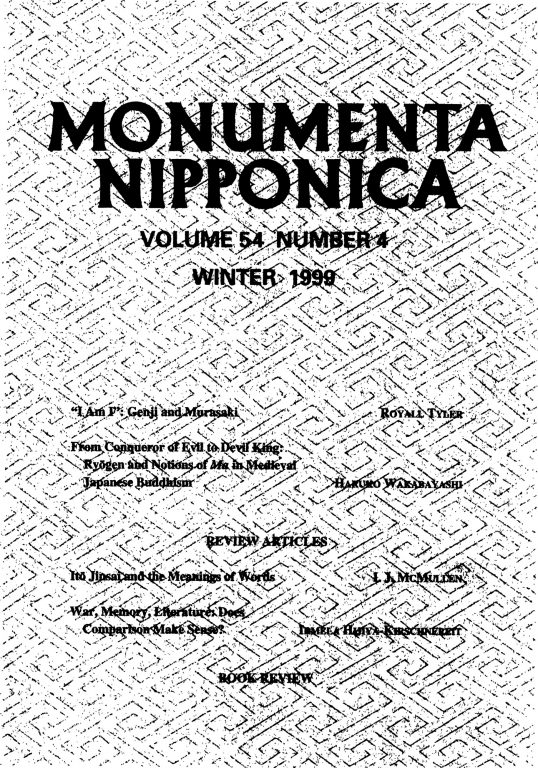 MN 54:4 (1999) 435–80“I Am I”: Genji and MurasakiRoyall Tyler
MN 54:4 (1999) 435–80“I Am I”: Genji and MurasakiRoyall Tyler MN 54:4 (1999) 481–507From Conqueror of Evil to Devil King: Ryōgen and Notions of Ma in Medieval Japanese BuddhismHaruko Wakabayashi
MN 54:4 (1999) 481–507From Conqueror of Evil to Devil King: Ryōgen and Notions of Ma in Medieval Japanese BuddhismHaruko Wakabayashi MN 54:4 (1999) 509–520Itō Jinsai and the Meanings of WordsI. J. McMullen
MN 54:4 (1999) 509–520Itō Jinsai and the Meanings of WordsI. J. McMullen MN 54:4 (1999) 521–528War, Memory, Literature: Does Comparison Make Sense?Irmela Hijiya-Kirschnereit
MN 54:4 (1999) 521–528War, Memory, Literature: Does Comparison Make Sense?Irmela Hijiya-Kirschnereit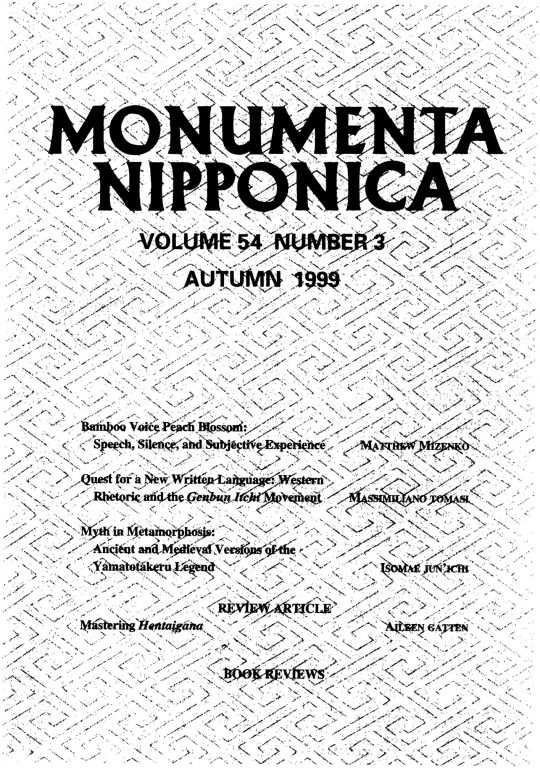 MN 54:3 (1999) 305–31Bamboo Voice Peach Blossom: Speech, Silence, and Subjective ExperienceMatthew Mizenko
MN 54:3 (1999) 305–31Bamboo Voice Peach Blossom: Speech, Silence, and Subjective ExperienceMatthew Mizenko MN 54:3 (1999) 333–60Quest for a New Written Language: Western Rhetoric and the Genbun Itchi MovementMassimiliano Tomasi
MN 54:3 (1999) 333–60Quest for a New Written Language: Western Rhetoric and the Genbun Itchi MovementMassimiliano Tomasi MN 54:3 (1999) 361–85Myth in Metamorphosis: Ancient and Medieval Versions of the Yamatotakeru LegendJun'ichi Isomae
MN 54:3 (1999) 361–85Myth in Metamorphosis: Ancient and Medieval Versions of the Yamatotakeru LegendJun'ichi Isomae MN 54:3 (1999) 387–93Mastering HentaiganaAileen Gatten
MN 54:3 (1999) 387–93Mastering HentaiganaAileen Gatten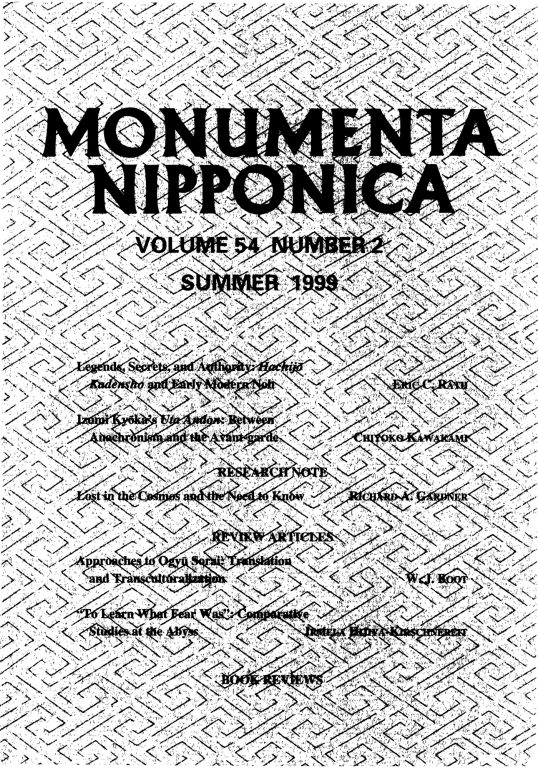 MN 54:2 (1999) 169–94Legends, Secrets, and Authority: Hachijō Kadensho and Early Modern NohEric C. Rath
MN 54:2 (1999) 169–94Legends, Secrets, and Authority: Hachijō Kadensho and Early Modern NohEric C. Rath MN 54:2 (1999) 195–215Izumi Kyōka’s Uta Andon: Between Anachronism and the Avant-gardeChiyoko Kawakami
MN 54:2 (1999) 195–215Izumi Kyōka’s Uta Andon: Between Anachronism and the Avant-gardeChiyoko Kawakami MN 54:2 (1999) 217–46Lost in the Cosmos and the Need to KnowRichard A. Gardner
MN 54:2 (1999) 217–46Lost in the Cosmos and the Need to KnowRichard A. Gardner MN 54:2 (1999) 247–58Approaches to Ogyū Sorai: Translation and TransculturalizationW. J. Boot
MN 54:2 (1999) 247–58Approaches to Ogyū Sorai: Translation and TransculturalizationW. J. Boot MN 54:2 (1999) 259–65“To Learn What Fear Was”: Comparative Studies at the AbyssIrmela Hijiya-Kirschnereit
MN 54:2 (1999) 259–65“To Learn What Fear Was”: Comparative Studies at the AbyssIrmela Hijiya-Kirschnereit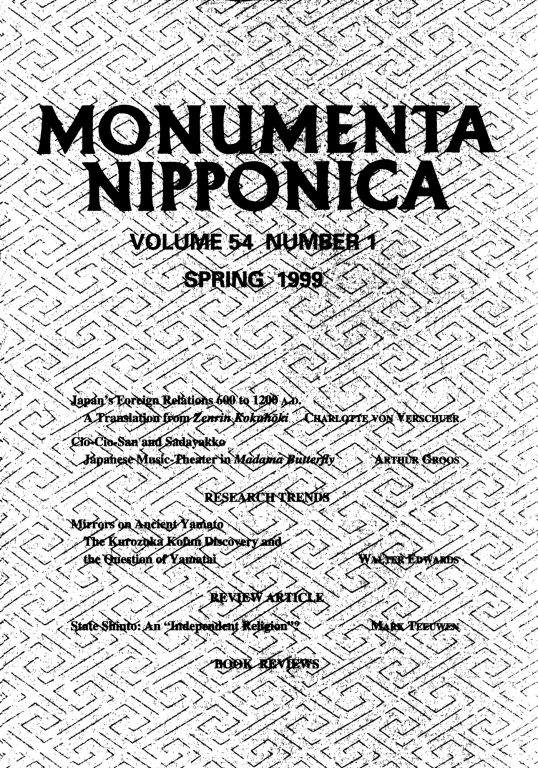 MN 54:1 (1999) 1–39Japan’s Foreign Relations 600 to 1200 A.D.: A Translation from Zenrin KokuhōkiCharlotte von Verschuer
MN 54:1 (1999) 1–39Japan’s Foreign Relations 600 to 1200 A.D.: A Translation from Zenrin KokuhōkiCharlotte von Verschuer MN 54:1 (1999) 41–73Cio-Cio-San and Sadayakko: Japanese Music-Theater in Madama ButterflyArthur Groos
MN 54:1 (1999) 41–73Cio-Cio-San and Sadayakko: Japanese Music-Theater in Madama ButterflyArthur Groos MN 54:1 (1999) 75–10Mirrors on Ancient Yamato: The Kurozuka Kofun Discovery and the Question of YamataiWalter Edwards
MN 54:1 (1999) 75–10Mirrors on Ancient Yamato: The Kurozuka Kofun Discovery and the Question of YamataiWalter Edwards MN 54:1 (1999) 111–21State Shinto: An “Independent Religion”?Mark Teeuwen
MN 54:1 (1999) 111–21State Shinto: An “Independent Religion”?Mark Teeuwen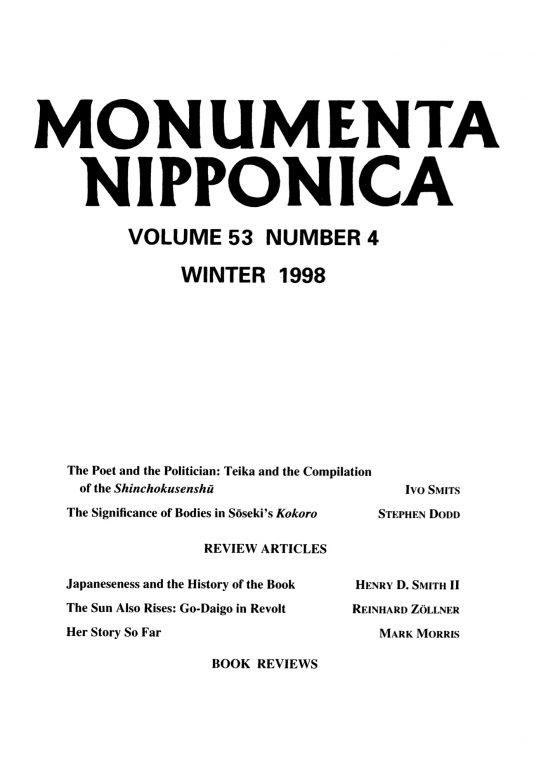 MN 53:4 (1998) 427–72The Poet and the Politician: Teika and the Compilation of the ShinchokusenshūIvo Smits
MN 53:4 (1998) 427–72The Poet and the Politician: Teika and the Compilation of the ShinchokusenshūIvo Smits MN 53:4 (1998) 473–98The Significance of Bodies in Sōseki’s KokoroStephen Dodd
MN 53:4 (1998) 473–98The Significance of Bodies in Sōseki’s KokoroStephen Dodd MN 53:4 (1998) 499–515Japaneseness and the History of the BookHenry D. Smith II
MN 53:4 (1998) 499–515Japaneseness and the History of the BookHenry D. Smith II MN 53:4 (1998) 517–527The Sun Also Rises: Go-Daigo in RevoltReinhard Zöllner
MN 53:4 (1998) 517–527The Sun Also Rises: Go-Daigo in RevoltReinhard Zöllner MN 53:4 (1998) 529–547Her Story So FarMark Morris
MN 53:4 (1998) 529–547Her Story So FarMark Morris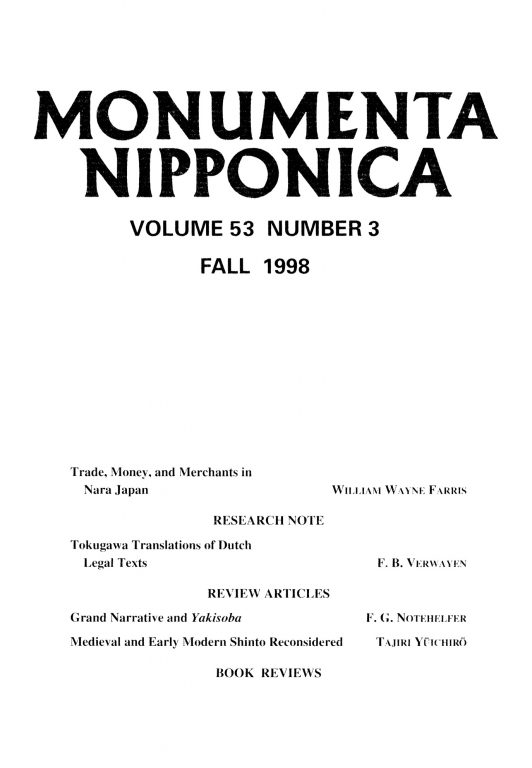 MN 53:3 (1998) 303–34Trade, Money, and Merchants in Nara JapanWilliam Wayne Farris
MN 53:3 (1998) 303–34Trade, Money, and Merchants in Nara JapanWilliam Wayne Farris MN 53:3 (1998) 335–58Tokugawa Translations of Dutch Legal TextsF. B. Verwayen
MN 53:3 (1998) 335–58Tokugawa Translations of Dutch Legal TextsF. B. Verwayen MN 53:3 (1998) 359–73From Grand Narrative to YakisobaF. G. Notehelfer
MN 53:3 (1998) 359–73From Grand Narrative to YakisobaF. G. Notehelfer











